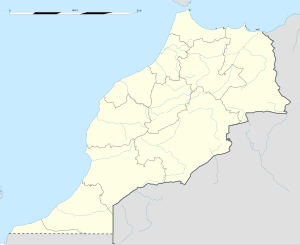Tamegroute (also spelled Tamgrout; Berber: ⵜⴰⵎⴳⵔⵓⵜ , Arabic: تامكروت) is a village located in the Draa River valley in southern Morocco. It historically served as a hub of learning and religion through its famous Sufi zawiya. This was a historical center of the Nasiriyya order, one of the most influential (and at one time one of the largest) Sufi orders in the Islamic world. Tamegroute's glazed ceramics are also very well known.
Tamegroute
ⵜⴰⵎⵖⵔⵓⵜ تامكروت | |
|---|---|
 | |
| Coordinates: 30°16′N 5°40′W / 30.267°N 5.667°W | |
| Country | |
| Region | Drâa-Tafilalet |
| Population (2014) | |
• Total | 21,603 |
| Time zone | UTC+0 (WET) |
| • Summer (DST) | UTC+1 (WEST) |
Climate
edit| Climate data for Tamegroute | |||||||||||||
|---|---|---|---|---|---|---|---|---|---|---|---|---|---|
| Month | Jan | Feb | Mar | Apr | May | Jun | Jul | Aug | Sep | Oct | Nov | Dec | Year |
| Mean daily maximum °C (°F) | 20.4 (68.7) |
22.7 (72.9) |
26.1 (79.0) |
30.9 (87.6) |
35.6 (96.1) |
41.0 (105.8) |
45.1 (113.2) |
43.8 (110.8) |
36.8 (98.2) |
31.1 (88.0) |
25.2 (77.4) |
20.5 (68.9) |
31.6 (88.9) |
| Mean daily minimum °C (°F) | 4.1 (39.4) |
6.2 (43.2) |
9.8 (49.6) |
13.3 (55.9) |
17.4 (63.3) |
21.7 (71.1) |
25.4 (77.7) |
25.4 (77.7) |
20.1 (68.2) |
15.3 (59.5) |
10.7 (51.3) |
5.6 (42.1) |
14.6 (58.3) |
| Average precipitation mm (inches) | 3 (0.1) |
3 (0.1) |
4 (0.2) |
1 (0.0) |
1 (0.0) |
0 (0) |
1 (0.0) |
3 (0.1) |
5 (0.2) |
11 (0.4) |
13 (0.5) |
6 (0.2) |
51 (2.0) |
| Source: Climate-data.org | |||||||||||||
History
editTamegroute has been a religious center since the 11th century. It had a religious school made famous by Abu Hafs Umar b. Ahmed al Ansari in 1575–76. The Nasiriyya order took its name from founder Sidi Muhammad bin Nasir al-Drawi (1603–1674), who took over teaching at the Tamegroute zawiya in the 1640s.[1]
The 19th sheikh Abu Bekr is well-known, in the Draa valley (zawiya in Mhamid Ghuslan) and in the west through his encounters with the travelers Gerhard Rohlfs[2] and Charles de Foucauld. In order to view the books at the library, a permit must be obtained from the Moroccan government, which allows you to handle the books inside the library only. The books collected by Ali Ben include texts on medicine, Qu'ranic learning and astrology, as well as mathematics and the sciences.[3]
Moussem
editA month after the greatest Islam holy day of Aid el-Kebir, Tamegroute hosts the yearly Moussem (festival) honoring Sidi Muhammad bin Nasir.
Pottery
editThe outdoor weekly market (souk) is held on Saturdays in the city center, where people can admire all kinds of pottery.[4]
Abu-l-Hasan Ali Ibn Mohammed al-Tamgruti
editTamegroute was the place of birth of one of the most important officials of the Saadian court, the author and ambassador Abu-l-Hasan Ali Ibn Mohammed al-Tamgruti, best known because of the rihla of his journey to Istanbul in 1590–91 for Ahmad al-Mansur.[5]
Bibliography and external links
edit- Ph.D. Thesis: "Between God and men : the Nasiriyya and economic life in Morocco, 1640–1830" by David Gutelius. Johns Hopkins University, 2001.
- The Nasiriyya - Abstract from David Gutelius' dissertation, "Market Growth and Social Change in the Western Maghrib, 1640-1830."[1]
- Article: The path is easy and the benefits large: The Nasiriyya, social networks and economic change in Morocco, 1640–1830, from: The Journal of African History, Gutelius, David P.V., 01-Jan-02 [2][permanent dead link]
- Book chapter: "Sufi networks and the Social Contexts for Scholarship in Morocco and the Northern Sahara, 1660-1830" by David Gutelius. In "The Transmission of Learning in Islamic Africa ed. Scott Reese. Leiden: Brill Academic Press, 2004.
- Agriculture, Sufism and the State in Tenth/Sixteenth-Century Morocco, by Francisco Rodriguez-Manas, Bulletin of the School of Oriental and African Studies, University of London, Vol. 59, No. 3 (1996), pp. 450–471 [3]
- The Nasiri supplication [4]
- Example of a manuscript (from Timbouctou) in the library of the Nasiryya [5]
- Dalil Makhtutat Dar al Kutub al Nasiriya, 1985 (Catalog of the Nasiri zawiya in Tamagrut), (ed. Keta books)
See also: Darqawa and Nasiriyya (Sufism) "the 19th century was the Darqawi century, just as the 18th century had been the Nasiri century"
Footnotes
edit- ^ For more information in the scholarly influence of the Nasiriyya, "Sufi networks and the Social Contexts for Scholarship in Morocco and the Northern Sahara, 1660–1830" by David Gutelius. In "The Transmission of Learning in Islamic Africa Archived 2007-07-16 at the Wayback Machine ed. Scott Reese. Leiden: Brill Academic Press, 2004.
- ^ Gerhard Rohlfs, Mein erster Aufenthalt in Marokko und Reise südlich vom Atlas durch die Oasen Draa und Tafilet, Bremen, 1873, Chapter 15: Die Draa-Oase. Mordversuch auf den Reisenden. Ankunft in Algerien Archived 2007-09-28 at the Wayback Machine
- ^ cf. Gutelius, "Sufi networks and the Social Contexts for Scholarship in Morocco and the Northern Sahara, 1660–1830"
- ^ List of weekly open-air markets in the province of Zagora
- ^ Tamegruti is the author of Al-Nafha al Miskiya fi al Sifara al Turkiya (Arabic title), (A 16th century travel account of Istanbul by a Moroccan ambassador), Keta-books, 2002 (French translation: Relation d'une ambassade marocaine en Turquie, 1589–1591, par Abou-l-Hasan Ali ben Mohammed et-Tamgrouti, traduite et annotée par Henry de Castries, Paris, 1929)
